What’s the best way to tell area residents about plans for a new asylum shelter nearby?
The government should tell communities directly about plans for new asylum shelters, some activists and politicians say.
Imagine St Stephen’s Green in swathes of fabric. It almost happened in the 1970s when artist Christo Javacheff arrived in town.

Sometimes, a public art installation draws global attention.
The silver Cloud Gate by British-Indian artist Anish Kapoor at the centre of one of Chicago’s plazas. Or the steely Angel of the North by Antony Gormley, which rises up near near Gateshead in the UK’s Tyne and Wear.
Nearly forty years ago, St Stephen’s Green was close to having its own cultural moment.
It was 1977, and the famous artist Christo Javacheff had arrived in Ireland. With him, he brought sketches of a new project he had been working on.
The previous year, he had completed his Running Fence installation in California, which involved a crisp, nylon sheet, five and a half feet tall, stretched across 24 miles of Sonoma and Marin counties.
He had now turned his attention to Dublin.
Together with his late wife Jeanne Claude, Christo — who is known by his first name because he’s that much of a big shot — is famous for his installation of temporary public works of art which, designed on a large scale, frequently use fabric as the primary medium.
In 1985, the couple literally wrapped the Pont Neuf bridge in Paris; in 1995, it was the Reichstag in Berlin.

Their projects demonstrate “how the impact of temporary artworks can powerfully resonate long after the work is complete,” writes Cliodhna Shaffery on the Irish Museum of Modern Art website.
As part of the 1977 ROSC exhibition, Christo showed drawings which proposed to wrap the walkways around Stephen’s Green. Inspired by the Japanese ceremonial use of gardens, the paths all around the park were to be cloaked in white fabric for several weeks.
The ROSC exhibitions, which ran from 1967 to 1988, were the brainchild of artist Michael Scott. Each exhibition featured a range of Irish and international artists, and aimed, as Scott said in an introduction to one of the shows, to “illuminate and augment the appreciation of the ancient art of Ireland”.
Christo’s proposal was always going to be a hard sell, though.
“As with every true work of art, [our work] has absolutely no purpose whatsoever,” he told Sculpture.org. “It is not a message, it is not a symbol, it is only a work of art.”
How did this thinking play with local authorities back in the 1970s?
At the time, Irish Times art critic, Brian Fallon, recounted viewing the proposal by “The Bulgarian Christo”. He was unmoved by the idea of “covering the paths in Stephen’s Green in billowy fabrics”, and dismissed the project as “pointless and wasteful”.
The works that Christo had behind him were epic, and, it has to be said, costly.
Running Fence in California, according to the artist’s website, consisted of “forty two months of collaborative efforts, eighteen public hearings, three sessions at the Superior Courts of California, and the drafting of a 450-page Environmental Impact Report”.

The artist’s works have proved challenging undertakings, and they still are today. His latest project, The Floating Piers, which is due to run this summer at Lake Iseo in Italy, will consist of “70,000 square meters of shimmering yellow fabric, carried by a modular floating dock system of 200,000 high density polythene cubes”.
Jeanne-Claude and Christo were crowdfunding before it became hip. As a team, they would sell drawings, collages and scale models of their proposals in order to raise the funds to ensure the project’s completion; purchase an original design, see the real thing realised. Running Fence came in at around $2.5 million, and it cost $13 million to wrap the Reichstag.
Although sketches of the Dublin proposal were sold prior to the ROSC exhibition, the decision for the project’s ultimate approval or denial fell with local authorities. In the end, it was denial.
It’s hard to pin down exactly who denied permission for the installation in Stephen’s Green. The Office of Public Works, as the caretaker of the park, is the most likely candidate.
In 1977, the Irish Times reported that Christo “was probably aware he would have trouble, to which he is no stranger”, and also that “the Board of Works forbade the whole enterprise while it was still only an idea”. By the time ROSC ’77 opened, the project had been shelved.
Dublin never saw its walkways wrapped.
Christo and Jeanne-Claude moved on to Kansas City, Missouri. In 1978, the paths of Loose Park were decorated with 135,000 square feet of golden nylon. In less than three days, the artist’s site says, “eighty-four workers, including thirteen professional seamstresses with portable sewing machines” completed the project.
The couple went on to wow with projects in Paris and Berlin, and later Miami, Rome and New York. In 2005, they stretched 7,503 saffron-coloured panels through Central Park, for The Gates project.
In 2010, preparatory sketches for the Stephen’s Green project were sold at auction for $80,500 to a private collector. During ROSC ’77, the Dublin Corporation purchased the original sketches of the proposal, which are now kept in the Hugh Lane archive.
Get our latest headlines in one of them, and recommendations for things to do in Dublin in the other.